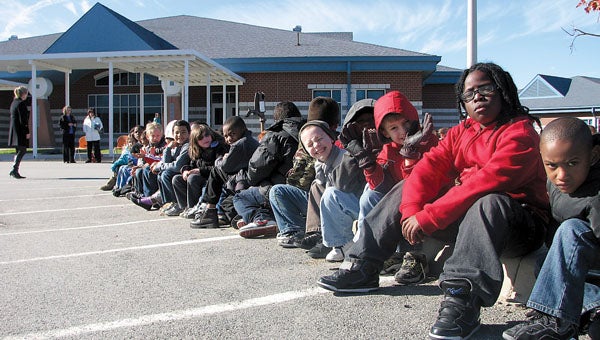North Suffolk schools deal with more students
Published 11:20 pm Saturday, December 3, 2011

Recess: Students from Creekside Elementary School take their recess on the blacktop where the buses park multiple times during the week because the playgrounds can’t accommodate the school’s 930 students every day.
During the past 10 years, North Suffolk has seen a rapid influx of people, and many of these new residents come with little citizens of their own.
As a result, schools in that area have had to adapt to constantly growing student populations. That growth is especially evident in the elementary schools.
Northern Shores and Creekside elementary schools, for example, have grown to nearly 1,000 students each as a result of the growth in their districts.
“Running a school with that many students means there are definitely challenges, but with challenges, there are always solutions,” Creekside Principal Katrina Rountree said. “Everyone becomes flexible, because people know there are a lot of students.”
Creekside opened in 2006 to deal with the growth in the North and take pressure off schools like Florence Bowser and Driver elementary, and the school has always had more than 600 students.
The year it opened, Rountree said, Creekside had about 650 students, but that number has increased every year since. This year, Creekside has about 930 students.
“It’s been gradual,” she said. “Around 2008-2009 school year, we could see the numbers growing.”
Northern Shores, which was built in 1996, has about 760 students, but unlike Creekside, the population has been steady for a while, principal Tara Moore said.
“With so many military families, we hold steady at about 760 because of people moving in and out,” she said. “For the past three years, we’ve been at that number.”
Still, Moore said, her school is still one of the largest in Suffolk, with more students than almost all of Suffolk’s elementary schools and two of the middle schools.
Both principals struggle with the challenges of large student populations.
The biggest concern, Moore said, is having enough staff to ensure the safety of every child.
“We have to have our eyes open wide to ensure students stay safe,” she said.
This becomes an even bigger challenge when a large number of the students are together, for example, during the loading and unloading of the buses or in the cafeteria for lunch, Moore said.
She said it takes a lot of flexibility and coordination to ensure everything runs smoothly.
“You can’t call all 12 buses at once, because you don’t want 600 students out there at once,” she said.
Additionally, she said, Northern Shores has to adjust its lunch schedules because so many kids have to eat.
As a result, the school starts serving kindergarteners at 11 a.m. and fifth graders don’t eat until after 1 p.m.
“We are doing the same things (as other schools) in less time,” she said. “It takes all of us in the building to make it work. The most important thing to have with a big school is flexibility.”
Like Moore, Rountree said, keeping a schedule is tough with a large population.
“There’s never a dull moment with 930 students,” she said.
Rountree said even simple tasks, like making sure the floors are waxed, take extra consideration, because the halls see so much traffic.
While school logistics are of great concern to the administrators, parents are usually more concerned about the class sizes. Because Suffolk Public Schools participates in the state’s K-3 class size initiative, class sizes are controlled for kindergarten through third grade.
Both Northern Shores and Creekside have had to add on extra teachers, usually taken from other schools in Suffolk, to maintain those class sizes.
“This year, we were at capacity for first and third grades,” Rountree said.
Creekside added a first-grade teacher, giving the school eight first grade classes.
One surprising challenge for Creekside has been outside the building.
The school’s three playgrounds cannot accommodate all of the grades, so several times a week, recess is held on the blacktop where the buses park.
Because the North Suffolk schools are so densely populated, Suffolk plans a new 800-student elementary school, set for design funding five years from now.
“Looking at the number of houses being built, we need to look at another school,” Moore said.
Rountree hopes her school’s population will even out.
“I’m hoping it’s leveling off, but I know we still have homes that are vacant and neighborhoods with empty houses,” she said. “I hope we don’t hit that 1,000 mark anytime soon.”
But, she added, “If we do hit that mark, I’m confident we can handle it.”





